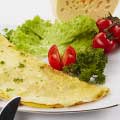
The great thing about fall is that it’s the perfect weather for braising. During this economic downturn everyone is looking for better ways to save money without sacrificing flavor. Instead of purchasing expensive cuts, such as tenderloins and high-end steaks, spend wisely on lesser cuts of meat. They are tougher cuts but when cooked properly, they yield deeper flavor than their expensive counterparts. By switching to these economical cuts—which include brisket, short ribs, shanks, rump, stewing meat, etc.—you can eat meat without making a dent in your budget. Tougher meats benefit from long and slow cooking.
Braising is the moist cooking method by which meats are browned in oil and then partly covered in liquid; they are then left to simmer, undisturbed, for a long period of time (usually hours), until they are fork-tender. Stews are braises too, except that the meat is cut into small pieces and more liquid is added.
This cooking technique may seem intimidating at first glance but it is one of the easiest to master. Chances are that if you own a slow cooker, you have braised before. The most time consuming aspect—albeit necessary—is browning the meat, but this forms the flavor capsules that ultimately season the braising liquid and it’s not hard to do.
One of my favorite Latin braises is carne mechada and mechar, means to lard a piece of meat. This is usually done by cutting a large hole into a piece of meat and stuffing it with bacon. In Latin America, butchers will cut your favorite cut of meat so that you can cook it this way but I’ve devised an easy way to make it at home without the need of a butcher. Instead of cutting a large piece off the center of the meat, I make smaller incisions with a sharp knife and use the handle of a wooden spoon to widen them; then I insert a mixture of chopped bacon and aromatics into each incision.
Read Related: Warm Hearts & Tummies with Cocido Madrileño
There are many recipes for carne mechada—in fact, as many as there are cooks—and mine is a simple braise that uses white wine as the braising liquid. You don’t have to use an expensive bottle of wine for this recipe and you can use chicken or beef broth instead, with the same delicious results.
A tough economy might call for tougher cuts of meat; however there is no need to sacrifice flavor in the process.
Large pieces of meat that have been larded with bacon and other ingredients and are then braised are called carne mechada. You will find many variations of this comforting braise served throughout Latin America. This is an easy rendition, perfect for the fall season. Since braised meats taste even better the next day and since they freeze beautifully, I’ll often make this recipe for my family and freeze the rest or leave it for later in the week. Like many Latin Americans, I like to serve this over white rice.
BRAISED CARNE MECHADA
Serves: 4
Ingredients:
One 3 ½ lb rump roast or eye of round roast
4 oz thick cut bacon, sliced into pieces
¾ cup peeled and sliced carrots
¾ cup manzanilla olives (or alcaparrado)
2 large garlic cloves
1 ½ TSP fine sea salt
1 TSP ground or dried thyme
½ TSP freshly ground black pepper
¼ cup olive oil
2 cups sliced white onion
1½ cups sliced plum tomatoes
2 cups dry white wine
Instructions:
- Dry the rump roast well with paper towels. Use a very sharp knife to cut 20 deep incisions into the roast. As you go along, use the handle of a wooden spoon to insert into each incision, twisting it, in order to make large holes that go all the way through the piece of meat (like channels). Set meat aside.
- In a food processor, combine the bacon, carrots, olives, and garlic cloves; process into a paste. Stuff this paste into each incision made into the roast. Rub the roast with salt, thyme, and pepper.
- In a large Dutch oven, set over medium-high heat, heat the oil and brown the meat on all sides, about 6 minutes total. Add the onions, tomatoes, and the wine; bring liquid to a boil. Cover the Dutch oven with a tight-fitting lid; lower the heat and simmer the meat for 1 ½ to 2 hours or until the meat is easily pierced with a fork.
- Remove the roast from the Dutch oven and place it on a platter; cover it with aluminum foil to keep warm.
- In the meantime, degrease the liquid in the pot and transfer the remaining liquid and any solids collected at the bottom of the pot (including the onions and tomatoes) into a blender; blend until smooth and return to the pot. Slice the meat into thin slices and return them to the pot; bring the liquid back to a simmer and heat the meat through. Serve over rice.












